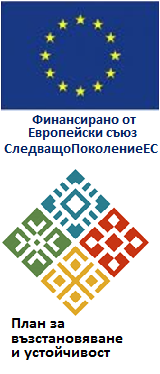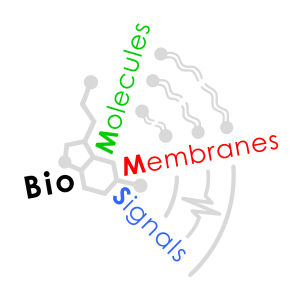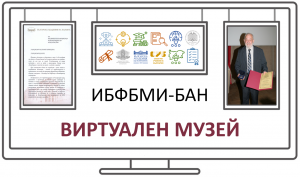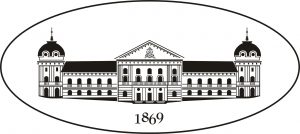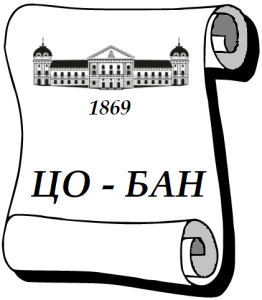The Best Method for Supramolecular Architecture – the Langmuir and Blodgett Method. Nanocomposite Chemical Sensor Applications with Novel Concepts for Ultrasensitive In-Field Real-Time Detection of Air and Water Emerging Contaminants. Possibilities for Joint EU Projects (M-ERA.NET; Widening/Teaming)
George R. Ivanov
1University Laboratory “Nanoscience and Nanotechnology” and Department of Physics, University of Architecture, Civil Engineering and Geodesy; and Advanced Technologies Ltd.; and NanoBioSense Ltd., Sofia, Bulgaria
Abstract:
Recently we combined ultra-sensitive gravimetric transduction by a 434 MHz two-port Surface Acoustic Wave (SAW) resonator with gold electrodes with Electrochemical Impedance Spectroscopy (EIS) on the same device, utilizing the strong enhancing effect of the interdigitated microelectrodes of the SAW device. The emerging contaminant PFOS –“forever chemical” because of the very strong C-F bonds, among the most dangerous compounds (USA EPA norms) of the 20 PFAS contaminants that have to be monitored following the latest (2020) EU directive on water intended for human consumption was detected. It was very selectively captured and measured almost in real-time by a Langmuir-Blodgett (LB) monolayer from a mixture of the Metal-Organic (MOF) MIL-101(Cr) and different lipids and phospholipids [1]. This concept, but this time only AA or DPPE-NBD LB monolayers were tested for non-selective Volatile Organic Compounds (VOC) measurements in the gas phase [2]. The huge sensitivity, not fully disclosed yet (patents pending) is due not only to the new concepts in signal transduction (see Figure right), but also to the novel effects discovered over the last 38 years of the very special DPPE-NBD fluorescently head labeled phospholipid, which closely mimics the biomembrane lipid “sea” in which protein or other molecules are embedded (see Figure left) [3, 4]. All the transduction electronics are palm-hand-sized and can be powered by a GPS tracker with satellite communication for planting the sensor before and after the city’s water purification systems for in-field quasi-real-time monitoring, without current commercial analog and a replacement of HPLC tandem Mass Spectroscopy expensive and time-consuming laboratory tests, currently in use.
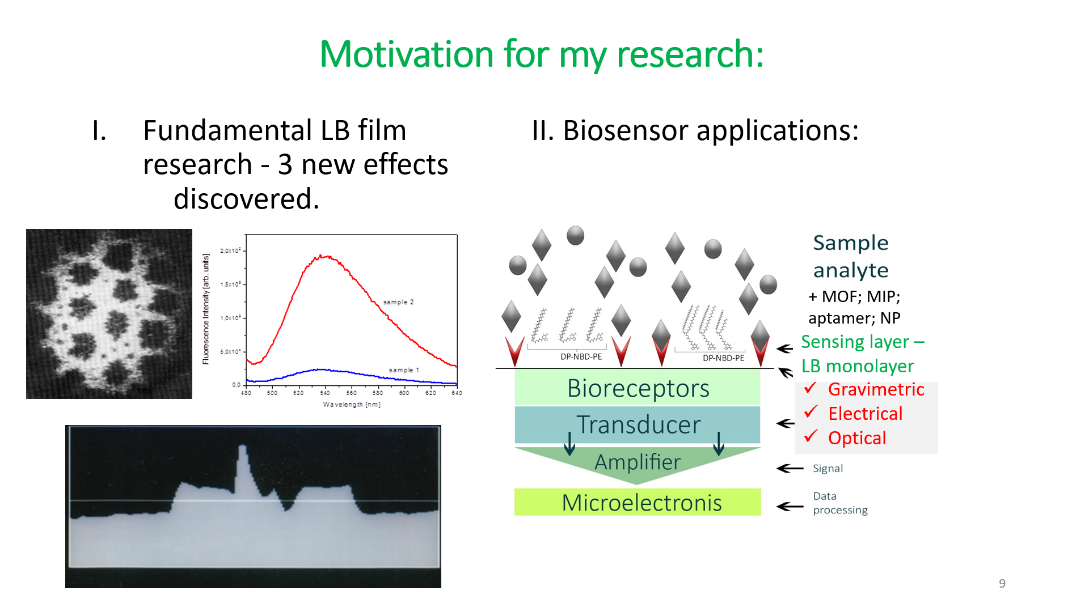
Среща по проект КП-06-Н88/6/2024 за координиране на дейностите по проекта.
References
1] Ivanov, G.R. et all. First Direct Gravimetric Detection of Perfluorooctane Sulfonic Acid (PFOS) Water Contaminants, Combination with Electrical Measurements on the Same Device—Proof of Concepts Chemosensors 2024, 12, 116 https://doi.org/10.3390/chemosensors12070116 ;
2] I.D. Avramov and G.R. Ivanov, Layer by Layer Optimization of Langmuir–Blodgett Films for Surface Acoustic Wave (SAW) Based Sensors for Volatile Organic Compounds (VOC) Detection, Coatings 2022, 12, 669 https://doi.org/10.3390/ coatings12050669;
3] G. R. Ivanov, First observation of fluorescence self-quenching in Langmuir films, Chem. Phys. Lett., 193 (1992) 323;
4] G.R. Ivanov et al., First observation of 3D aggregates in a single-component Langmuir film below the equilibrium spreading pressure (2017) https://doi.org/10.1051/ matecconf/20179801003
Biography of the presenting author:
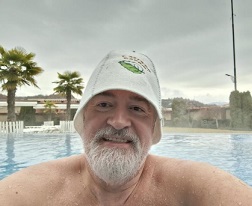 Currently the best-funded scientist from the Bulgarian NSF Assoc. Prof. Dr. George R. Ivanov has an M.Sc. in engineering physics (1987) from the Faculty of Physics of the #1 Uni in Bulgaria – Sofia University. Deputy-Rector for Science was his M.Sc. thesis head – TCSPC fluorescence in the IR sub-nanosecond kinetic measurements of AIIIBV semiconductors; PhD from the Institute of Solid State Physics – Bulg. Acad. Sci. – LB films instrumentation and DPPE-NBD structure and applications (2003) with consultant the then youngest Academician Prof. D.Sc. Alexander G. Petrov. He registered his first company Advanced Technologies Ltd. in 1994 and sold an LB system in the Lab of our recent Prime Minister Acad. N. Denkov in 1995, then penetrated with his LB systems and patch-clamp amplifiers the Japanese (Distributor – Seiko Instruments), Korean, and Italian markets since 1996-97. In 2009 he moved to his current second-oldest and #1-rated technical university in Bulgaria (UACEG) and currently heads the Department of Physics. Founder and Head of the University (reporting directly to the Rector) Nano Lab since 2016. The owner (70%), CEO, and CTO of NanoBioSence Ltd. with 4 other highly ranked professors from the Bulgarian Academy of Sciences. Currently has the best-equipped LB technological and research Lab in the world, which is further currently upgraded with an epifluorescence wide-field Zeiss (Germany) microscope, equipped with an Andor (UK) sensitive camera with super-resolution capabilities and PicoQuant (Germany) TCSPC Picosecond Fluorescence Kinetics channel – first and only in the world!
Currently the best-funded scientist from the Bulgarian NSF Assoc. Prof. Dr. George R. Ivanov has an M.Sc. in engineering physics (1987) from the Faculty of Physics of the #1 Uni in Bulgaria – Sofia University. Deputy-Rector for Science was his M.Sc. thesis head – TCSPC fluorescence in the IR sub-nanosecond kinetic measurements of AIIIBV semiconductors; PhD from the Institute of Solid State Physics – Bulg. Acad. Sci. – LB films instrumentation and DPPE-NBD structure and applications (2003) with consultant the then youngest Academician Prof. D.Sc. Alexander G. Petrov. He registered his first company Advanced Technologies Ltd. in 1994 and sold an LB system in the Lab of our recent Prime Minister Acad. N. Denkov in 1995, then penetrated with his LB systems and patch-clamp amplifiers the Japanese (Distributor – Seiko Instruments), Korean, and Italian markets since 1996-97. In 2009 he moved to his current second-oldest and #1-rated technical university in Bulgaria (UACEG) and currently heads the Department of Physics. Founder and Head of the University (reporting directly to the Rector) Nano Lab since 2016. The owner (70%), CEO, and CTO of NanoBioSence Ltd. with 4 other highly ranked professors from the Bulgarian Academy of Sciences. Currently has the best-equipped LB technological and research Lab in the world, which is further currently upgraded with an epifluorescence wide-field Zeiss (Germany) microscope, equipped with an Andor (UK) sensitive camera with super-resolution capabilities and PicoQuant (Germany) TCSPC Picosecond Fluorescence Kinetics channel – first and only in the world!
Other Details:
- Email: george@at-equipment.com
- Alternative email: g_ivanov_fhe@uacg.bg
- Contact Number: +359 885 465 535
- LinkedIn: George R. Ivanov
- University: www.uacg.bg
- www.nano.uacg.bg – Under update
- Advanced Technologies Ltd.: www.at-equipment.com
- Facebook page: www.Facebook.com/NoLimitsWellnessTeam
- Alpinism blog: www.at-equipment.com/alpinism – Under recovery


